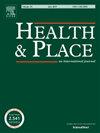徒步穿越欧洲:高分辨率步行指数的开发。
IF 4.1
2区 医学
Q1 PUBLIC, ENVIRONMENTAL & OCCUPATIONAL HEALTH
引用次数: 0
摘要
缺乏身体活动在很大程度上导致肥胖和其他非传染性疾病,但提高全民身体活动水平的努力收效甚微。建筑环境在鼓励步行等积极行为方面起着关键作用。适宜步行指数综合了各种环境特征,为促进健康、适宜步行的环境提供了一个有价值的工具。然而,欧洲一直缺乏一个标准化的、高分辨率的步行指数。这项研究通过为整个欧洲地区开发一个标准化的、高分辨率的步行指数来解决这一差距。选择七个核心要素来定义可步行性:可步行街道长度、十字路口密度、绿地、坡度、公共交通通道、土地利用组合和15分钟步行等时线。这些数据来源于统一的高分辨率数据集,如Sentinel-2、NASA的高程模型、OpenStreetMap和CORINE Land Cover。一个100米× 100米的分层网格系统和先进的地理空间方法,如网络缓冲和距离衰减,在规模上有效地模拟现实世界的密度和邻近效应。以人口为权重,采用视觉映射、空间聚类和相关分析等方法对不同空间层次的指数进行分析。研究结果显示了明显的城乡梯度,高步行性得分集中在街道连通性和土地利用多样性丰富的紧凑城市中心。该指数将巴塞罗那、柏林、慕尼黑、巴黎和华沙等城市列为最适宜步行的城市。这个标准化的、高分辨率的步行指数是研究人员、规划人员和政策制定者的实用工具,旨在支持欧洲不同背景下的积极生活和公共健康。本文章由计算机程序翻译,如有差异,请以英文原文为准。
A Walk across Europe: Development of a high-resolution walkability index
Physical inactivity significantly contributes to obesity and other non-communicable diseases, yet efforts to increase population-wide physical activity levels have met with limited success. The built environment plays a pivotal role in encouraging active behaviors like walking. Walkability indices, which aggregate various environmental features, provide a valuable tool for promoting healthy, walkable environments. However, a standardized, high-resolution walkability index for Europe has been lacking. This study addresses that gap by developing a standardized, high-resolution walkability index for the entire European region. Seven core components were selected to define walkability: walkable street length, intersection density, green spaces, slope, public transport access, land use mix, and 15 min walking isochrones. These were derived from harmonized, high-resolution datasets such as Sentinel-2, NASA’s elevation models, OpenStreetMap, and CORINE Land Cover. A 100 m 100 m hierarchical grid system and advanced geospatial methods, like network buffers and distance decay, were used at scale to efficiently model real-world density and proximity effects. The resulting index was weighted by population and analyzed at different spatial levels using visual mapping, spatial clustering, and correlation analysis. Findings revealed a distinct urban-to-rural gradient, with high walkability scores concentrated in compact urban centers rich in street connectivity and land use diversity. The index highlighted cities like Barcelona, Berlin, Munich, Paris, and Warsaw as walkability leaders. This standardized, high-resolution walkability index serves as a practical tool for researchers, planners, and policymakers aiming to support active living and public health across diverse European contexts.
求助全文
通过发布文献求助,成功后即可免费获取论文全文。
去求助
来源期刊

Health & Place
PUBLIC, ENVIRONMENTAL & OCCUPATIONAL HEALTH-
CiteScore
7.70
自引率
6.20%
发文量
176
审稿时长
29 days
期刊介绍:
he journal is an interdisciplinary journal dedicated to the study of all aspects of health and health care in which place or location matters.
 求助内容:
求助内容: 应助结果提醒方式:
应助结果提醒方式:


